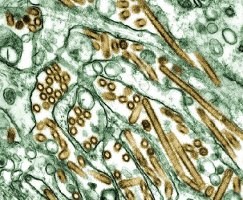[PT]

Gripe aviária (gripe das aves em Portugal) é o nome dado à doença causada por uma variedade do vírus Influenza (H5N1) cujo hospedeiro são aves, mas que pode infectar diversos mamíferos. Tendo sido identificada em Itália por volta de 1900, é, no entanto, conhecida por existir em grande parte do globo, concentrando-se hoje principalmente no sudeste asiático. Existem também casos recentes na Turquia, Roménia e Inglaterra (apenas aves foram infectadas nos três lugares).
O H5N1, vírus causador da gripe aviária, é um tipo de vírus Influenza, o responsável pela gripe comum. O Influenza pode ser dividido em três tipos: A, B e C. O tipo A subdivide-se ainda em vários subtipos, sendo os subtipos H1N1, H2N2 e H3N2, responsáveis por grandes epidemias e pandemias. O tipo B também tem originado epidemias mais ou menos extensas e o tipo C está geralmente associado a casos esporádicos e surtos localizados.
Excepto a nível molecular, a doença parece-se muito pouco com a gripe que todos apanhamos de vez em quando. O vírus pode tornar-se uma grande ameaça para os humanos se sofrer alguma mutação transformando-se em algo perigosamente desconhecido pelo nosso organismo e capaz de passar de uma pessoa para outra através de espirros, tosse ou contacto físico.
Como outros vírus, a evolução do influenza pode ocorrer aleatóriamente por rearranjo de genes ou de forma mais perigosa, com trocas de genes entre estirpes diferentes.
As pandemias que ocorrem mais ou menos a cada geração, mas de forma imprevisível, podem iniciar-se se uma das muitas variantes da influenza que circula entre pássaros passar a infectar também as pessoas. Feito isso, é possível que ocorra troca de genes entre o vírus da gripe comum (altamente infeccioso) com o influenza (altamente perigoso). Se o vírus se replicar muito antes do sistema imunitário conseguir produzir anticorpos para detê-lo, a epidemia pode alastrar-se causando vários problemas de saúde pública, podendo mesmo ser extremamente letal.
O subtipo H5N1 foi isolado pela primeira vez em estorninhos, em 1961, na África do Sul. Até então só se tinha conhecimento da ocorrência do vírus Influenzae AH5N1 em diferentes espécies de aves (daqui a designação de "gripe das aves"), incluindo galinhas, patos e gansos, sabendo-se ainda que a maior parte das galinhas infectadas morriam num curto espaço de tempo e que patos e gansos eram os principais portadores do vírus. Em Maio de 1997, o vírus Influenzae AH5N1 foi isolado pela primeira vez em humanos, numa criança de Hong Kong. Em 2006 foram comprovados na Alemanha a morte de gatos infectados pelo vírus.
[EN] 
Influenza A virus subtype H5N1, also known as A(H5N1) or simply H5N1, is a subtype of the Influenza A virus which can cause illness in humans and many other animal species.[1] A bird-adapted strain of H5N1, called HPAI A(H5N1) for "highly pathogenic avian influenza virus of type A of subtype H5N1", is the causative agent of H5N1 flu, commonly known as "avian influenza" or "bird flu". It is endemic in many bird populations, especially in Southeast Asia. One strain of HPAI A(H5N1) is spreading globally after first appearing in Asia. It is epizootic (an epidemic in nonhumans) and panzootic (affecting animals of many species, especially over a wide area), killing tens of millions of birds and spurring the culling of hundreds of millions of others to stem its spread. Most mentions of "bird flu" and H5N1 in the media refer to this strain.[2]
HPAI A(H5N1) is an avian disease. There is no evidence of efficient human-to-human transmission or of airborne transmission of HPAI A(H5N1) to humans. In almost all cases, those infected with H5N1 had extensive physical contact with infected birds. Still, around 60% of humans known to have been infected with the current Asian strain of HPAI A(H5N1) have died from it, and H5N1 may mutate or reassort into a strain capable of efficient human-to-human transmission. In 2003, world-renowned virologist Robert Webster published an article titled "The world is teetering on the edge of a pandemic that could kill a large fraction of the human population" in American Scientist. He called for adequate resources to fight what he sees as a major world threat to possibly billions of lives.[3] On September 29, 2005, David Nabarro, the newly-appointed Senior United Nations System Coordinator for Avian and Human Influenza, warned the world that an outbreak of avian influenza could kill anywhere between 5 million and 150 million people.[4] Experts have identified key events (creating new clades, infecting new species, spreading to new areas) marking the progression of an avian flu virus towards becoming pandemic, and many of those key events have occurred more rapidly than expected.
Due to the high lethality and virulence of HPAI A(H5N1), its endemic presence, its increasingly large host reservoir, and its significant ongoing mutations, the H5N1 virus is the world's largest current pandemic threat, and billions of dollars are being spent researching H5N1 and preparing for a potential influenza pandemic.[5] At least 12 companies and 17 governments are developing pre-pandemic influenza vaccines in 28 different clinical trials that, if successful, could turn a deadly pandemic infection into a nondeadly one. Full-scale production of a vaccine that could prevent any illness at all from the strain would require at least three months after the virus's emergence to begin, but it is hoped that vaccine production could increase until one billion doses were produced by one year after the initial identification of the virus.[6]
H5N1 may cause more than one influenza pandemic as it is expected to continue mutating in birds regardless of whether humans develop herd immunity to a future pandemic strain.[7] Influenza pandemics from its genetic offspring may include influenza A virus subtypes other than H5N1. While genetic analysis of the H5N1 virus shows that influenza pandemics from its genetic offspring can easily be far more lethal than the Spanish Flu pandemic[9], planning for a future influenza pandemic is based on what can be done and there is no higher Pandemic Severity Index level than a Category 5 pandemic which, roughly speaking, is any pandemic as bad as the Spanish flu or worse; and for which all intervention measures are to be used.[10]
While genetic analysis of the H5N1 virus shows that influenza pandemics from its genetic offspring can easily be far more lethal than the Spanish Flu pandemic[9], planning for a future influenza pandemic is based on what can be done and there is no higher Pandemic Severity Index level than a Category 5 pandemic which, roughly speaking, is any pandemic as bad as the Spanish flu or worse; and for which all intervention measures are to be used.[10]
[PT] A cache:é uma multi, de 3 pontos, que poderá ser um pouco díficil de encontrar para a malta menos experiente e daí a dificuldade mais elevada. De resto, a ideia é que seja uma cache divertida, como contraponto ao seu tema (e porque às vezes há ideias que não aguentam quietas  ).
).
NÃO COLOQUEM fotos ou textos nos logs que estraguem a surpresa aos próximos geocachers, por favor! As caches requerem algum cuidado na sua manipulação, mas são de abertura fácil. Obrigado pela atenção.
[EN] The cache:It's a 3 step multi, that can be a little harder to find to those with less experience. Hence the higher difficulty. Anyway, the idea was to build a fun cache, as an opposite to its subject (and because sometimes, some ideas just won't stay still  ).
).
PLEASE AVOID any pictures or text in your logs that may spoil the surprise for the next Geocachers. The caches require some care when handling but are easy to open. Thank you for your attention!